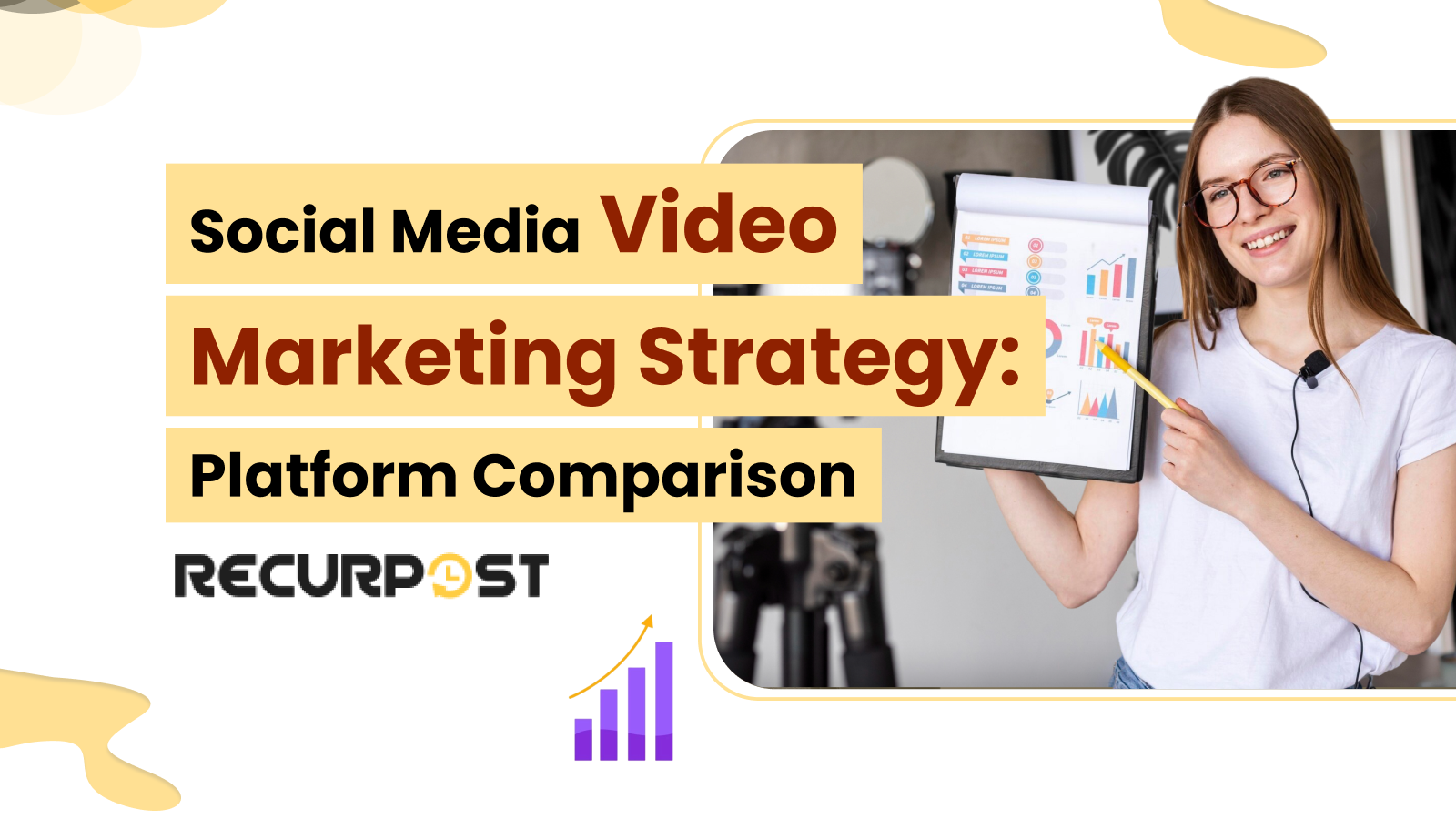Video content forms the foundation of modern marketing. Posts with video get 1200% more shares than those with just text or images (WordStream). Brands without video content marketing miss out on attention and clicks.
TikTok, Instagram Reels, and YouTube distribute content differently and attract different user behaviors. Platform choice determines whether identical video content or a Video Marketing Strategy succeeds.
TikTok thrives on discovery and quick hits, favoring short clips. Reels serve your Instagram crowd – your existing social media followers. YouTube supports both short bursts and long-lasting content.
Audience Behavior & Intent on Each Platform
User interaction patterns across platforms determine how effective your Video Marketing Strategy will be. Here’s a breakdown of user behavior across the three major platforms:
| Platform | User Intent | Embedded in the IG ecosystem | Avg. Session Time |
| TikTok | Engagement first | Algorithm feed (For You) | 58 mins/day |
| IG Reels | Passive engagement | Embedded in IG ecosystem | 43 mins/day |
| YouTube | Search and learn focused | Search and suggested content | 39 mins/day |
User behavior differences determine content performance and marketing funnel placement for your video and social media efforts:
- TikTok excels at top-funnel marketing. Users come to be entertained and discover new social content, making it ideal for brand awareness and initial engagement. With its algorithm-driven discovery, even accounts with small followings can achieve viral reach.
- Instagram Reels serves the mid-funnel effectively. Since it’s integrated within the broader Instagram experience, users often have existing relationships with brands they follow. This makes Reels perfect for nurturing interest and showcasing products to an audience already familiar with your brand.
- YouTube functions as a full-funnel platform. Its search-focused nature means users actively seek out video content, whether for entertainment, education, or product research. This intent-driven behavior makes YouTube particularly effective for conversion-focused content.
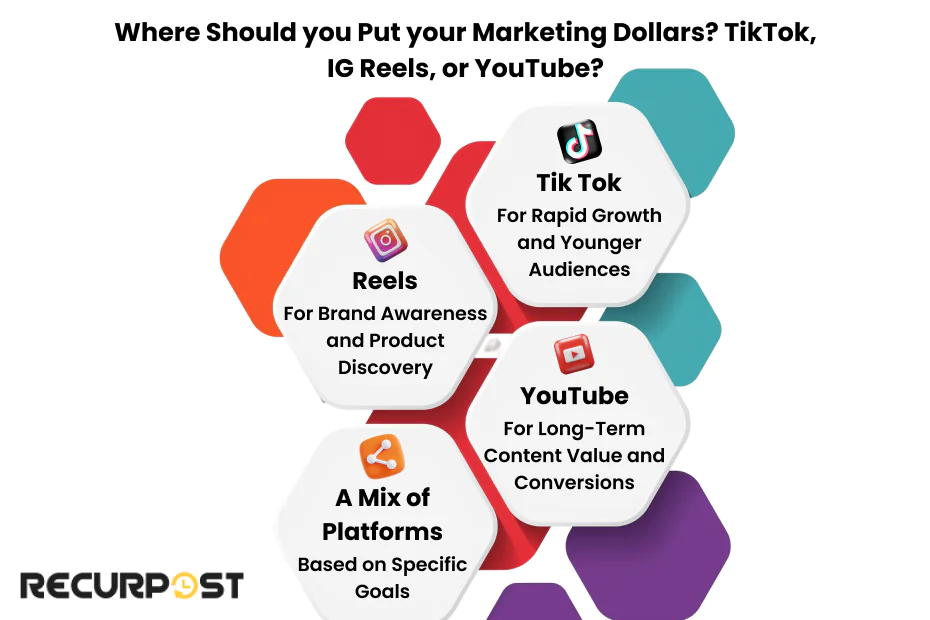
Algorithm Mechanics Breakdown
Platform algorithms shape content discovery and audience reach. Algorithm mechanics affect Video Marketing Strategy outcomes and social media video strategy planning:
| Platform | Key Signals | Boost Triggers | Content Lifespan |
| TikTok | Completion rate, shares | Trending sounds, high engagement in 30mins | ~48 hrs |
| Reels | Interactions, saves | IG engagement history | ~72 hrs |
| YouTube | CTR, watch time | SEO optimization, subscriber growth | Years |
TikTok’s algorithm favors rapid virality. It tests video content with a small audience, then expands distribution based on engagement levels. This creates opportunities for rapid growth but limits content lifespan to about 48 hours.
YouTube delivers slow growth but long-term ROI. Videos continue to attract audience engagement for years, especially with a strong video SEO strategy. This makes it ideal for evergreen video marketing strategy examples that provide lasting value.
Instagram Reels benefits from Instagram’s integrated social graph. Social media video content here often reaches users already active with related brands. This makes Reels effective when you’ve built an Instagram video marketing strategy.
Video Marketing Platform Comparison: By the Numbers
Performance metrics across media platforms guide expectation setting and resource allocation in Video Marketing Strategy planning for social media video marketing.
| Feature | TikTok | Instagram Reels | YouTube |
| Engagement Rate | 2.34% | 1.48% | 0.91% (long form), 3.87% (shorts) |
| Comment Rate | 0.22% | 0.07% | N/A (not a primary metric) |
| Key Audience | 18-34 years | 18-34 years (60%) | 25-34 years |
| Conversion Strength | Medium (impulse buys) | Low-mid (brand recall) | High (search + review purchases) |
| Unique Strength | Highest engagement | Product discovery (61%) | Search discovery, content lifespan |
| CPM | $10-$15 | $8-$12 | $15-$25 |
| Monthly Active Users (2024) | 2.6B | 2B (IG overall) | 2.5B |
| Video Length | 15s-10min (optimal: 15-30s) | 15-90s (optimal: 15-30s) | 60s-unlimited (optimal: 7-15min) |
| Algorithm Focus | Completion rate, initial engagement | Social graph, user history | Watch time, click-through rate |
| Shopping Integration | TikTok Shop with product tags | Instagram Shopping with checkout | Merch shelf, affiliate links |
Analysis of platform performance metrics for video content marketing funnel:
1. Correlation Between Metrics and Marketing Objectives
If your goal is brand awareness, TikTok’s superior engagement rate (2.34%) makes it ideal for social video marketing. Its algorithm puts videos in front of new audiences quickly, regardless of follower count.
For product discovery, Instagram Reels excels, with 61% of users finding new products. Instagram Shopping integration creates a smoother path from discovery to purchase within your Instagram video marketing strategy.
When conversion is the goal, YouTube’s conversion strength makes it the best video marketing strategy for considered purchases. Users watch product reviews and tutorials before buying, making YouTube a strong social media video strategy.
2. Long-term vs. Short-term Content Strategy Considerations
Short-term campaigns (1–4 weeks) work best on TikTok and Reels, where trending videos and sounds drive engagement, but video content has a shorter lifespan.
Medium-term plans (1–6 months) suit all platforms, with Reels offering a balance between immediate engagement tactics and moderate video content lifespan.
Long-term video content strategy (6+ months) brings the highest ROI on YouTube, where video marketing strategy examples keep generating views and conversions for years with a proper video SEO strategy.
3. Industry-Specific Implications
Direct-to-Consumer (DTC) brands perform well on TikTok and Reels for product showcasing and impulse purchases. Visual content and shopping tools make these media platforms ideal for physical items.
B2B SaaS companies rely on YouTube for product demonstrations and educational videos. The longer format supports detailed tutorials and establishes thought leadership within a digital video strategy.
EdTech organizations can use all three: TikTok for awareness and quick tips, Reels for course highlights, and YouTube for comprehensive educational content within a video content marketing strategy.
Integration Options for Social Media Video Marketing Strategy
Each platform offers unique integration paths for a unified Video Marketing Strategy and a stronger video content marketing funnel:
TikTok video marketing integrates with Facebook Ads Manager, Google Analytics, and Shopify through TikTok Business Center. Pixel tracking delivers 87% accurate conversion attribution for video ads.
Instagram video marketing strategy leverages Meta’s ecosystem for integration with Facebook and WhatsApp. Businesses using this approach in their video production workflows report 35% higher conversion tracking rates.
YouTube marketing strategy connects with Google Ads, Analytics, and Tag Manager. This strengthens your video content marketing funnel with SEO benefits unmatched by other media platforms.
Developing an Effective Video Marketing Strategy
Define Your Video Marketing Goals
Clarify your social media video marketing goals before using platform-specific tactics in your broader marketing strategy.
If you want to expand your audience and grow brand awareness, focus on metrics like view count, reach, and share rate. TikTok video marketing excels with algorithm-driven discovery that places content before new audiences, even without followers.
When the goal is building community around your brand, track engagement tactics such as comments, shares, and user-generated content. Both TikTok and Instagram Reels power community growth through challenges, duets, and interactive stickers.
If sales are the goal, measure click-through rate (CTR), conversion rates, and ROI. The YouTube marketing strategy works best for considered purchases, while TikTok and Reels push impulse buys with shopping integrations.
To establish your brand as an authority, focus on watch time, subscriber growth, and content saves. The YouTube video marketing strategy with long format and search-driven discovery is best for educational videos that show expertise.
Tip: Build a one-page social media video marketing strategy template listing a single goal, target audience analysis, platform, optimal video length (30–90 seconds), posting dates, and one metric to track.
Types of Video Marketing Content that are Most Effective for Businesses
Businesses use different video content strategies across the video content marketing funnel to reach target audiences. The most effective types of video marketing include:
- Listicles: Short social media videos in list format around trending or niche themes.
- Brand storytelling video strategy: Videos showing values, mission, and emotional connection with the audience.
- Behind-the-scenes content for brand humanization: Clips showing team dynamics and work processes.
- Event videos: Teasers or highlights from brand events and launches.
- Explainer videos: Educational videos that make tutorials clear and build trust.
- Q&A / Video testimonials for building credibility: Customer stories and interactive content marketing video strategy.
- Product demo video strategy: Walkthroughs, unboxings, and product showcases for marketing goals.
- 360 / VR content: Immersive video content creation for audience interaction.
- Animated videos for explaining complex concepts: Visual content strategy video for simplifying detailed ideas.
Know Your Audience Demographics
Platform demographics reveal where your target audience analysis shows people spend time, shaping your video marketing strategy.
1. TikTok’s Audience Profile
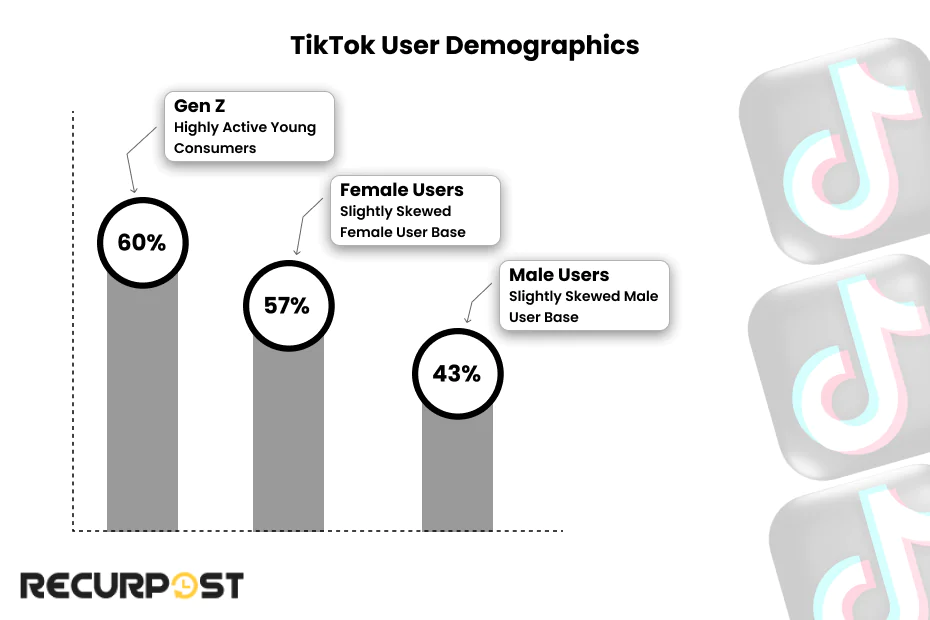
While TikTok video marketing began with Gen Z, its audience has broadened. Now, the 18–34 age group is the largest segment, though younger demographics still engage heavily with short-form video content.
Gen Z (born 1997–2012) remains active on TikTok, with 60% of users. This makes the platform vital for brands targeting younger audiences with short-form video content.
TikTok’s user base skews slightly female (57%). These ratios shift by region and content category.
TikTok users engage in multiple short sessions, averaging 8 app opens daily. They mainly want entertainment, discovery, and social media video marketing content, not detailed info.
2. Instagram Reels Audience Profile for Video Content Strategy
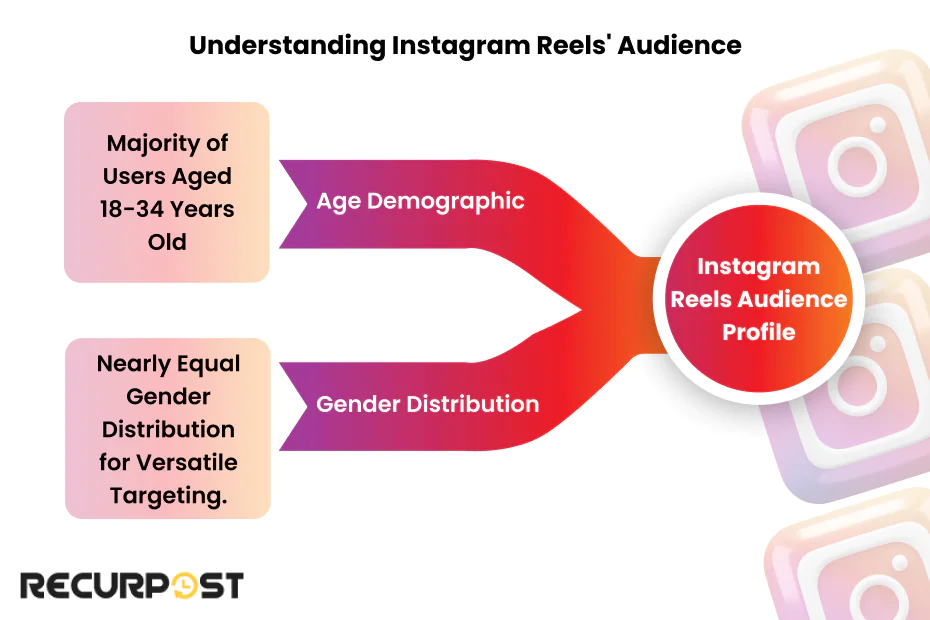
Instagram video marketing strategy reaches similar ages to TikTok (60% between 18–34), but Instagram overall skews slightly older, useful for wider video marketing efforts.
Reels show an equal gender split, making it versatile for brands using social media video marketing tips to target both genders.
Reels excels in visual niches like fashion, beauty, and lifestyle. Social video marketing here generates higher engagement tactics than other content types.
Instagram users show strong purchase intent, with 83% discovering products and services. Instagram video marketing tips with Shopping integration make Reels effective for product discovery.
3. YouTube’s Audience Profile
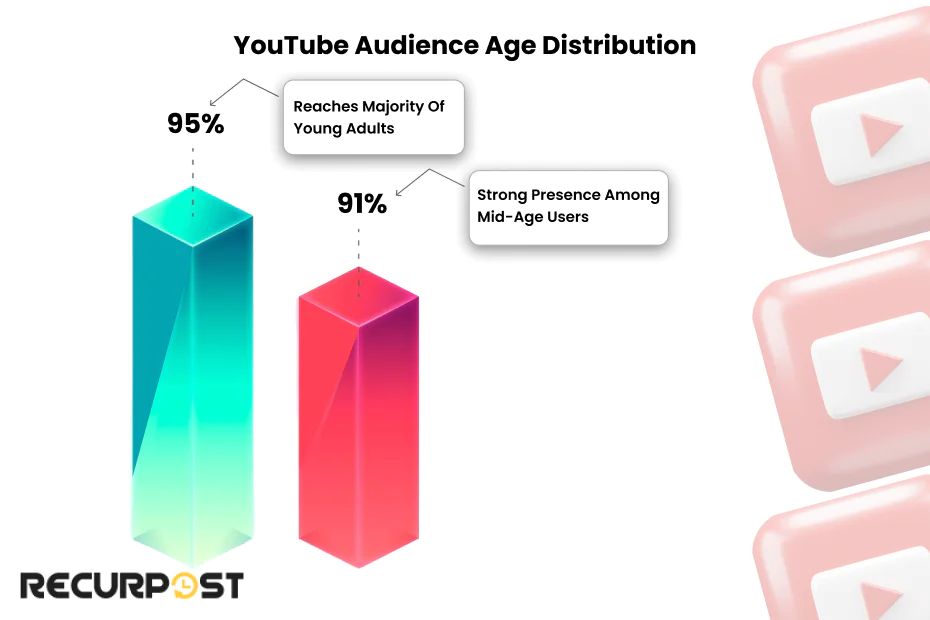
YouTube’s core audience is slightly older (25–34), making YouTube marketing strategy valuable for brands targeting young professionals with video content marketing strategy.
Unlike TikTok or Reels, YouTube reaches nearly all ages: 95% (18–29) and 91% (30–49). It offers unmatched media platforms and demographic breadth.
YouTube users commit to longer viewing sessions, seeking information, entertainment, or educational videos. Search-driven discovery boosts its role in video content strategies.
YouTube attracts more educated, higher-income users compared to other social media video platforms. Specifically, 51% hold college degrees, and 95% have incomes above $75,000, making it ideal for B2B video marketing and premium video marketing strategies.
Resource Allocation Strategy
Smart resource allocation maximizes returns on time and budget within your Video Marketing Strategy.
1. Platform-Specific Posting Frequency Recommendations
- TikTok: 3-5 posts weekly
TikTok video marketing favors consistent posting, but quality matters. Aim for 3–5 posts weekly for reach. Posting during peak hours (7–9 PM target audience time) boosts engagement tactics.
- Reels: 4-7 posts weekly
Instagram video marketing strategy benefits from steady activity. Publish 4–7 Reels weekly, spaced out for stronger social media video engagement.
- YouTube: 1-2 posts weekly
YouTube marketing strategy requires more video production but delivers a longer content lifespan. Post 1–2 high-quality videos weekly for a balanced video content strategy.
2. Production Quality Expectations by Platform
TikTok video marketing strategy values authenticity over polish. Raw, genuine short form videos outperform highly produced ones. Basic smartphone footage with natural light is enough.
Instagram marketing videos need a balance: polished yet natural. Reels content should match your Instagram aesthetic and support brand identity.
YouTube video marketing strategy demands higher production quality for long-form videos. Invest in strong audio, stable footage, and thoughtful video editing.
3. Time Investment Considerations
Each media platform requires different time investments:
TikTok video content creation typically takes 1–3 hours per video, covering planning, shooting, and post-production.
Instagram Reels take 2–4 hours per video, including planning, shooting, post-production, and integration with your Instagram video marketing strategy.
YouTube content marketing strategy is the most time-intensive, requiring 5–20+ hours. It covers research, scripting, filming, editing, and video SEO strategy.
4. Batch Creation Tools for Video Production
Tools to Streamline Multi-Platform Content Creation
Before creating social media videos, define your target audience demographics and preferred platforms. According to Hootsuite, January campaigns gain 22% higher engagement rates. Analyze video performance data to set goals for each platform.
Several tools improve the video creation process efficiency:
Canva Pro: Enables creating 10–15 videos for social media marketing with auto-resizing for different platforms like TikTok, Instagram, and YouTube. Templates stay current with platform specs.
CapCut: Enables batch editing across multiple videos with effects, transitions, and branding elements, cutting post-production time by approximately 60%.
Later: Planning and scheduling tool with a visual calendar. Its analytics track video performance metrics across formats and posting times.
RecurPost: Automates posting workflows for Instagram video marketing and notifications for TikTok video strategy, where APIs limit posting.
The Sprout Social Index shows that businesses using batch video content creation save 7.5 hours weekly while maintaining consistent quality across media platforms.
5. Platform Reviews for Large-Scale Marketing Campaigns
TikTok Video Marketing Strategy for Enterprise
- Strengths: Rapid brand awareness with 300-500% higher engagement rates than traditional platforms
- Best for: Gen Z and millennial-focused campaigns requiring immediate visibility
- Budget: $500/day minimum for enterprise reach in TikTok video marketing strategy
- Campaign duration: 2-4 weeks for maximum impact
- Key feature: Dedicated account managers and early access to beta features
Instagram Video Marketing Strategy with Reels for Scale
- Strengths: Reliable performance for product launches with precise targeting
- Best for: E-commerce brands and product-focused video marketing strategy examples
- Budget: $100-$10,000+ daily, depending on campaign scope
- Campaign duration: 1-3 months for sustainable growth
- Key feature: Shopping integration is driving 40% higher conversion rates than TikTok
YouTube Video Marketing Strategy for Long-Term ROI
- Strengths: Highest long-term return with 250% better cost-per-acquisition than traditional advertising
- Best for: B2B companies and high-consideration purchases
- Budget: Starting at $1,000/month for sustained presence
- Campaign duration: 6+ months for maximum ROI
- Key feature: Search-driven discovery creating compounding returns over time
Multi-Platform Allocation
- Awareness: 50% TikTok, 30% Reels, 20% YouTube
- Consideration: 30% TikTok, 40% Reels, 30% YouTube
- Conversion: 20% TikTok, 30% Reels, 50% YouTube
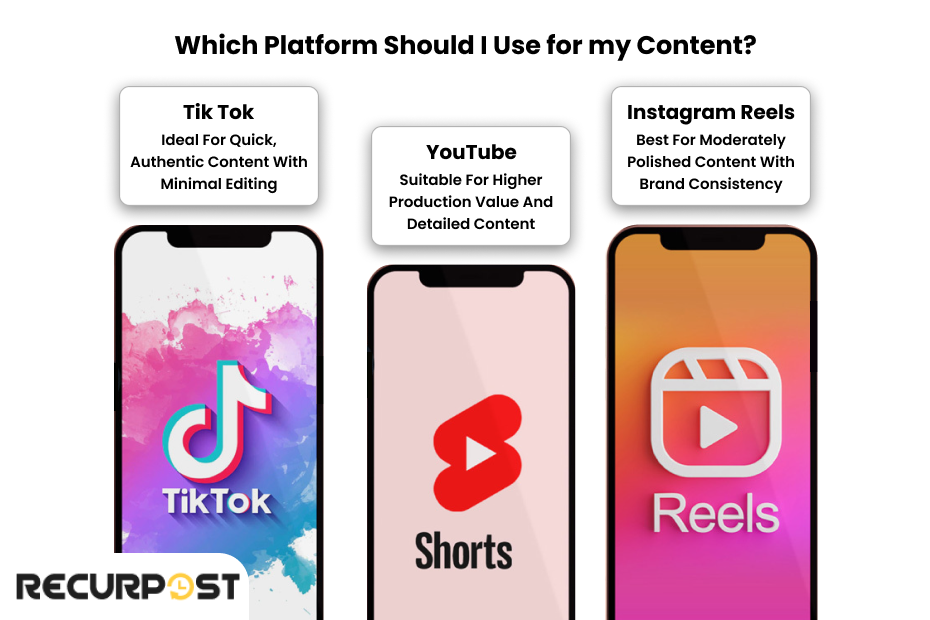
Monetization Paths for Social Media Video Marketing Strategy
| Platform | Creator Funds | Affiliate Support | eCommerce Tools |
| TikTok | Yes | Yes | TikTok Shop |
| Reels | Yes | Yes | IG Shopping |
| YouTube | Yes (best payouts) | Yes | Merch shelf |
Each media platform offers distinct video content marketing strategy opportunities through brand collaborations and creator-driven campaigns beyond standard monetization features.
1. TikTok video marketing excels with creator partnerships. Branded hashtag challenges drive massive engagement tactics. The Creator Marketplace helps brands find collaborators, making influencer content feel authentic instead of traditional advertising.
2. Instagram video marketing strategy benefits from Instagram’s influencer ecosystem. Tools for branded content tagging and tracking boost campaigns. Reels collaborations often deliver stronger conversion tracking than TikTok, though costs per engagement are higher.
3. YouTube marketing strategy offers advanced partnerships: long-term ambassador programs and co-created series. Its long format supports detailed product demo video strategy and reviews, making it strong for high-consideration purchases.
Free vs Paid Platform Features Comparison
Knowing free VS paid tiers in video marketing platforms helps businesses allocate budgets effectively within a video content marketing strategy.
| Platform | Free Features | Paid Features | Monthly Cost |
| TikTok | Basic analytics, organic posting, standard effects | TikTok Ads Manager, advanced targeting, custom effects | $20+ (ad spend) in TikTok video marketing strategy. |
| Instagram Reels | Basic insights, shopping tags, standard filters | YouTube Premium features, advanced analytics, and copyright matching | $0–$100+ (promotion budget) for Instagram video marketing strategy. |
| YouTube | Basic analytics, monetization, standard editing | YouTube Premium features, advanced analytics, copyright matching | YouTube Premium features, advanced analytics, and copyright matching |
TikTok Video Marketing Strategy
A. Key TikTok Features for Marketers
Content Creation Tools
TikTok provides a robust set of in-app editing tools, including:
- Video duration options (15 seconds to 10 minutes, with 15-60 seconds performing best)
- Effects, filters, and text overlays
- Sound library with trending audio
- Green screen and split-screen capabilities
These native tools make it easy to create engaging content without external editing software.
Marketing Capabilities in TikTok video marketing strategy
Beyond organic content, TikTok offers specialized marketing features:
- TikTok Shops for direct in-app selling
- Branded hashtag challenges to encourage user-generated content
- Spark Ads that amplify organic content
- Custom effects and stickers for branded campaigns
Algorithm Advantages for New Accounts
Unlike platforms that prioritize accounts with established followings, TikTok’s algorithm evaluates each video independently. This creates a level playing field where new accounts can achieve viral reach if their content resonates with viewers.
Related: TikTok marketing strategy and Best times to post on TikTok.
B. TikTok Marketing Strategy Implementation
Authenticity and Trending Sound Optimization
TikTok users value authenticity over polished production. Brands that show their human side typically outperform those with overly commercial content. Incorporating trending sounds can boost your visibility, as the algorithm favors content using popular audio.
First 3-Second Hook Techniques
The first three seconds of your TikTok video are crucial; videos with strong openings see 3× higher completion rates. Start with movement, an intriguing question, or a bold statement to capture attention immediately. Avoid logos or slow intros that might cause viewers to scroll past.
TikTok Marketing Success Tactics Outline
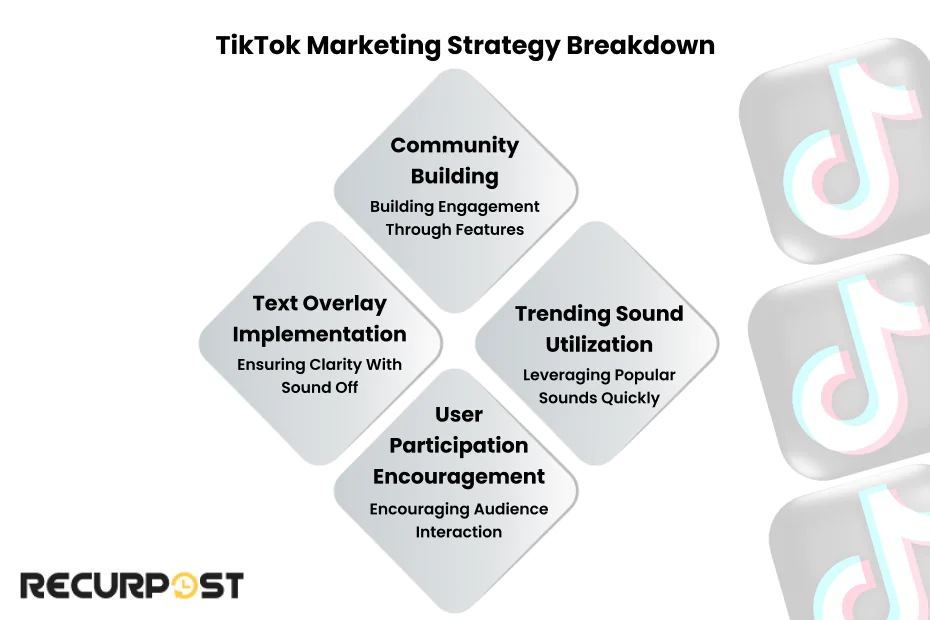
1. Trending Sound Utilization Timeline (24-48 hours)
When you spot a trending sound, act quickly; trends typically last just 24-48 hours on TikTok. Use TikTok’s Creative Center to identify rising sounds before they peak. Create multiple variations of your content using the same sound to maximize your chances of success.
2. User Participation Encouragement Methods
Encourage viewers to engage with your content through:
- Direct calls to action (“Comment if you agree”)
- Questions that prompt responses
- Challenges that invite participation
- “Stitch this” or “Duet this” prompts
Text Overlay Implementation for Sound
Off ViewingMany users watch TikTok with the sound off in public places. Include clear text overlays that communicate your key message without audio. Keep text concise and use high-contrast colors for readability.
Community Building via Duet and Stitch Features
TikTok’s Duet and Stitch features allow you to interact directly with your audience’s content. Respond to comments with video replies, duet user-generated content, and stitch relevant videos to build community engagement.
Case Study: Chipotle’s #GuacDance Challenge
Chipotle has mastered TikTok’s challenge format to drive engagement and brand awareness. As a compelling social media video marketing strategy example, their #GuacDance campaign, launched for National Avocado Day, encouraged users to dance for free guacamole.
The campaign generated over 250,000 video submissions and 430 million video starts in just six days, resulting in 800,000 sides of guacamole served. This highlights the effectiveness of interactive and fun challenges in engaging TikTok’s audience
Instagram Reels Marketing Strategy
A. Key Features for Instagram video marketing strategy
Content Creation Capabilities
Reels provides creation tools for video content strategy:
- 90-second video capability (optimal length is 15-30 seconds)
- Multi-clip editing with alignment tools
- Audio library with trending songs
- Effects and AR filters
- Speed controls and transitions
Marketing Benefits of an Instagram Video Marketing Strategy
Reels benefit from the Instagram ecosystem within social media marketing platforms comparison:
- Instagram Shopping integration for product tagging
- Reels tab discovery for expanded reach
- Cross-promotion with Stories and feed posts
- Hashtag reaches beyond your followers
Analytics and Measurement Tools
Instagram provides detailed insights for Reels, including:
- Plays, likes, comments, and shares
- Reach and accounts reached
- Saves and website clicks
- Audience demographics
B. Reels Marketing Strategy Development
Reels succeed when part of a full Instagram video marketing strategy, leveraging the platform ecosystem.
Cross-Promotion Approach with Stories and Feed Posts
Reels performs best as part of an integrated Instagram strategy. Promote your Reels through Stories with a “New Reel” sticker to drive immediate views. Share Reels to your feed to extend their lifespan and reach. Create teaser content in Stories that directs viewers to your full Reel for more information.
Instagram Reels Marketing Success Tactics Outline
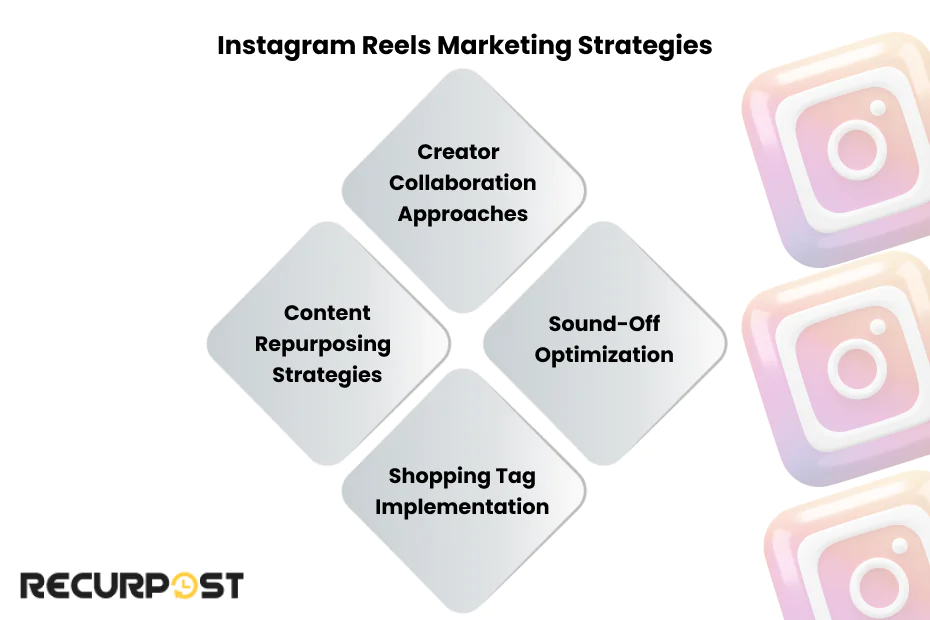
1. Sound-Off Optimization (85% of Facebook/Instagram Videos Watched Muted)
With 85% of Facebook and Instagram videos watched without sound, designing for sound-off viewing is essential. Use Instagram’s auto-captioning feature or add manual captions to ensure your message comes across clearly. Incorporate visual storytelling techniques that communicate without relying on audio.
2. Shopping Tag Implementation for Direct Purchasing
Instagram’s shopping features allow you to tag products directly in Reels. Place tags strategically on products being demonstrated or highlighted. Create dedicated product showcase Reels that function as shoppable mini-catalogs. Combine educational content with product tags for a soft-sell approach.
3. Content Repurposing Strategies from Other Platforms
When repurposing content from other platforms to Reels:
- Remove any watermarks from TikTok or other platforms
- Adjust aspect ratio to 9:16 vertical format
- Re-edit to highlight the most engaging segments
- Add Instagram-native text and effects
- Update captions and hashtags for Instagram’s audience
4. Creator Collaboration Approaches
Instagram’s collaboration features make it easy to work with creators:
- Use the Collab feature to co-author Reels with creators
- Leverage Branded Content tags for transparent partnerships
- Create custom AR effects for creator-led campaigns
- Develop branded audio for Instagram video marketing strategy examples
Case Study: Zomato applies Instagram video marketing strategy examples by sharing humorous social media videos on food cravings/delivery. This relatable content strategy video builds a connection while promoting services.
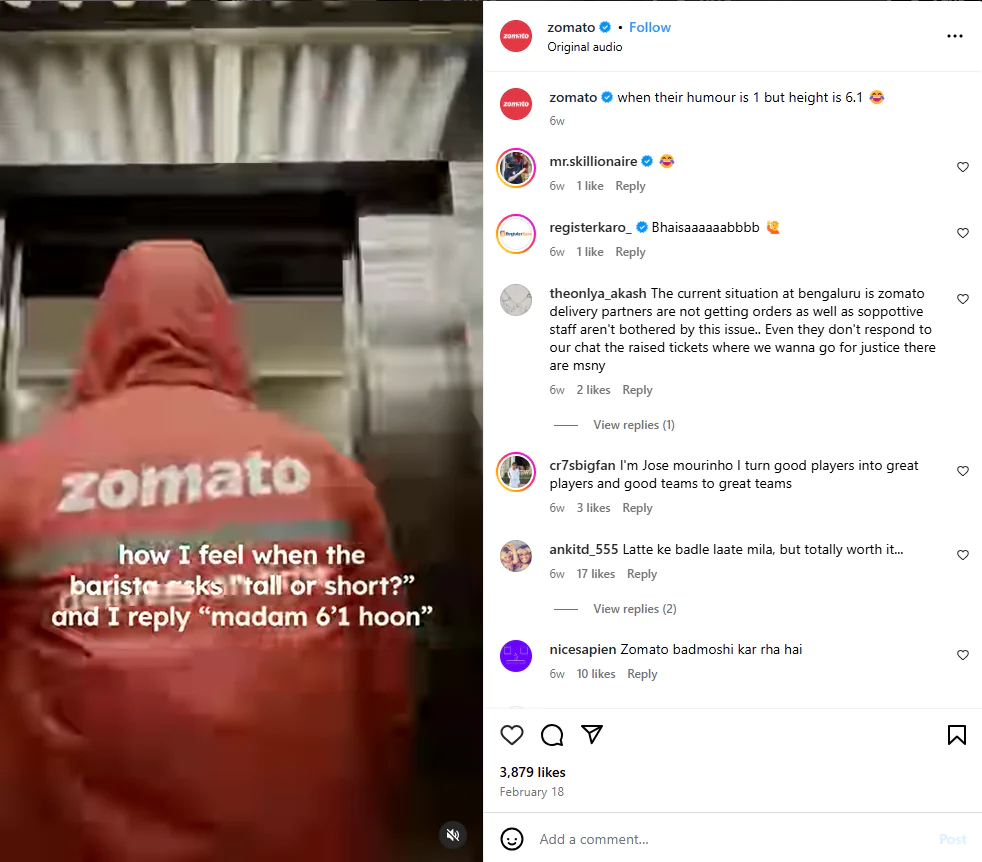
YouTube Video Marketing Strategy
A. Key Features of YouTube Marketing Strategy
Platform Advantages
YouTube provides unique benefits:
- Diverse formats (Shorts, standard videos, live streams, premieres)
- SEO capabilities through titles, descriptions, and tags
- Channel customization with branding elements
- Community tab for audience engagement
- Comprehensive monetization options
Marketing Benefits
YouTube’s role as a social media video platform and second-largest search engine gives video marketing strategy examples distinct advantages:
- 2.5B+ monthly users across diverse demographics
- High trust factor (YouTube is often used for product research)
- Long content lifespan (videos can generate views for years)
- Advanced targeting options for paid promotion
Content Lifespan Comparison
The longevity of YouTube content sets it apart from other platforms:
- TikTok/Reels: 24-48 hour typical engagement window
- YouTube: Years of potential visibility and engagement
This extended lifespan makes YouTube ideal for evergreen content that continues to deliver value over time.
B. ROI Tactics in YouTube marketing strategy
To maximize your return on investment with YouTube marketing, focus on optimization techniques that enhance both discovery and engagement.
Related: Best YouTube marketing strategy and best times to post on YouTube.
YouTube Video Marketing Success Tactics Outline:
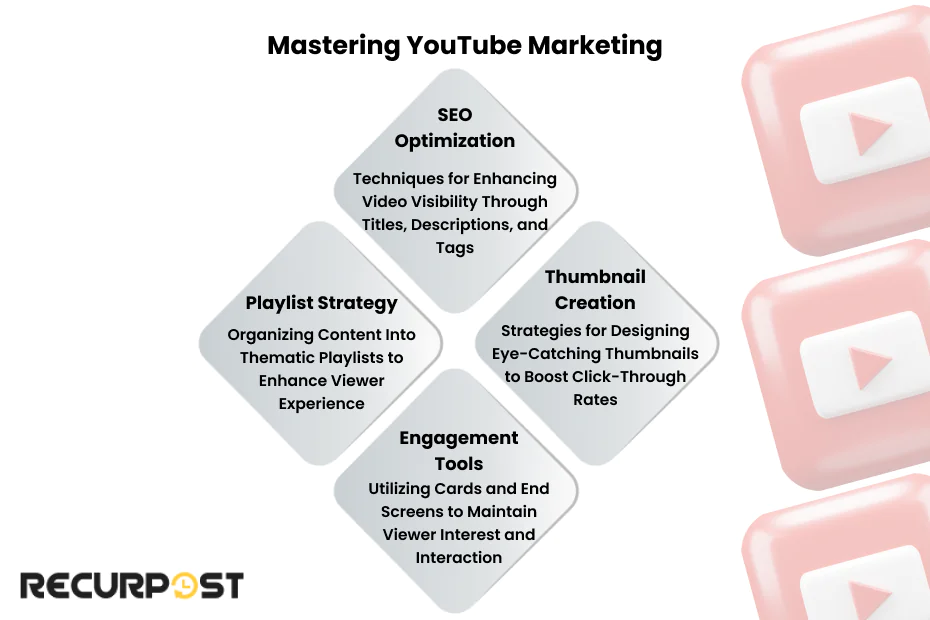
1. Title, Description, and Tag Optimization Techniques
YouTube is a search engine, so SEO matters:
- Include your primary keyword in the first part of your title
- Write detailed descriptions (300+ words) with relevant keywords
- Add timestamps to improve user experience and search visibility
- Use 10-15 relevant tags, starting with your most important
2. Create High-Impact Thumbnails
Thumbnails are your first impression, so make them count. Use close-up facial expressions, bold colors, minimal text (under six words), and clear branding. Custom-designed thumbnails can increase your click-through rate by up to 30%, helping your videos stand out in crowded search results.
3. Use Cards & End Screens
Add cards during natural breaks in your video to suggest related content and keep viewers engaged. In the final 20 seconds, use end screens to direct viewers to other videos, playlists, or CTAs like subscribing, encouraging longer viewing sessions, and more channel interaction.
4. Playlist Structuring in YouTube video marketing strategy
Organize your content into playlists grouped by topic and arranged in a logical flow, such as beginner to advanced. Keeping a consistent theme throughout can improve the viewer experience and increase average session duration by up to 50%.
Case Study: McDonald’s UAE used YouTube Shorts in its YouTube video marketing strategy. The “McCrispy, sound of joy” video reached 19.3M views + 447K engagements, proving the power of short-form video content.
Building a Cohesive Digital Video Marketing Strategy
A. Cross-Platform Content Planning
Repurposing Framework
Repurposing is vital in a video marketing strategy. Instead of creating brand-new videos for every platform, you can stretch a single YouTube video into multiple content pieces. For example, from one 10–15 minute YouTube video, you can easily extract:
- 3 TikToks that highlight key moments or fun insights
- 3 Instagram Reels focused on quick tips or visual features
- 1 YouTube Short summarizing the video
- 1 carousel post with eye-catching frames and text overlays
Each media platform has unique algorithms. Repurposing supports efficiency, strengthens cross-platform distribution, and grows audience reach.
Content Pillars for video content strategy
Keep 3–5 pillars in your social media video marketing strategy. They anchor brand identity and video content strategies. Example: A coach could use home workouts, nutrition tips, and client stories as content strategy video pillars.
Now adapt those themes for each platform’s vibe:
- On TikTok: Quick tips with trending audio
- On Reels: High-quality product visuals or short demonstrations
- On YouTube: Deep dives into your topic with step-by-step guides
Keep your messaging aligned, same voice, same values, even when formats change. That consistency builds trust and recognition, no matter where your audience finds you.
Content Waterfall Strategy
Content waterfall turns long-form YouTube video marketing strategy into smaller social media video marketing pieces. Here’s how:
- Identify top-performing moments using your audience retention graph
- Pull those segments out for TikTok and Reels
- Adjust style and edit length based on platform best practices
By repurposing smartly, you turn one shoot day into a week’s worth of content, boosting your ROI without burning out your team.
Platform Specialization Approach
Not all platforms serve the same purpose. Here’s how to position each one in your strategy:
- TikTok: Ideal for brand discovery and trend participation. 61% of users say they prefer brands that join trends.
- Instagram Reels: Use this for product showcasing. With built-in shopping and strong engagement (22% higher than regular posts), Reels are perfect for conversion.
- YouTube: Best for long-form, in-depth content. Viewers spend an average of 19 minutes per day here, great for tutorials, webinars, or storytelling.
How to Create a Video Marketing Strategy for Business
A. Pre-Production Planning
Start with SMART goals in your video marketing strategy: Specific, Measurable, Achievable, Relevant, Time-bound. Your objective, brand awareness, lead generation, or retention, guides the video creation process.
Build viewer personas with demographics, pain points, and preferred content styles. Script videos addressing their specific needs. Hook viewers in the first 10 seconds to increase completion rates by 23%.
Use this basic equipment checklist:
- Camera: Smartphone (iPhone 11 or newer), DSLR, or mirrorless
- Microphone: Lavalier or shotgun (60% of viewers leave because of poor audio)
- Lighting: Ring light or three-point setup
- Stabilization: Tripod or gimbal
- Editing tools: CapCut, InShot, Adobe Premiere, Final Cut
B. Production Tips by Platform
TikTok Production Tips
- Use a 9:16 ratio for TikTok videos
- Keep lighting bright and natural (ring lights work great)
- Segment recording = smoother video editing
- Record multiple takes to nail timing and avoid sloppy edits
Instagram Reels Tips
- Always integrate branded colors, fonts, or logos
- Use Instagram’s native tools (filters, audio) for 20% more reach
- Add text overlays sparingly for clarity
- Prioritize clean, smooth transitions for higher retention
YouTube Production Tips
- Stick to a 16:9 aspect ratio for desktop and mobile
- Invest in quality audio, it’s a dealbreaker
- Choose simple, brand-friendly backgrounds
- Hook viewers early, use pattern interrupts, and close with a strong CTA
C. Post-Production Best Practices
- Consistent branding across intros, styles, and palettes builds brand recognition
- Add captions for video accessibility, boosting completion rates by 12%
- Place call-to-action elements near the 70% mark for conversion tracking
- Use video SEO strategy: add keywords in titles, tags, descriptions
Tip: Batch video content creation saves 30–40% time and improves video marketing strategy consistency.
How Video Marketing Works: The Mechanics Behind the Scenes
A. Video Distribution Process
1. Algorithm Assessment Factors
Algorithm visibility requires strong early engagement: likes, comments, and shares within the first hour determine video reach.
Retention is king. Platforms favor videos that keep 60%+ of viewers watching until the end. They also track sentiment in comments, how often your content is shared, and how users interact with your content on the For You or Explore pages.
2. Testing Phase Mechanics
TikTok uses “test first, distribute later.” Video test with 300–500 users. If the engagement rate is > 6%, reach expands in the TikTok video marketing strategy.
Distribution flows in waves (1K → 10K → 100K+). Strong performance keeps content spreading for 5 days in viral video marketing strategies.
Want your video to go viral? Include at least 3 of these:
- Trendy topic
- Unexpected twist (pattern interrupt)
- Emotional pull
- Call for engagement (e.g., “Duet this!” or “Tag a friend!”)
3. Audience Targeting in Video Marketing Strategy
Social media platforms use audience behavior with similar content to refine targeting. Platforms analyze visuals, metadata, captions, and keywords to group video content strategy correctly.
Paid video ads add demographic filters. TikTok targeting delivers 72% higher accuracy than user-declared data
B. Success Metrics in video marketing strategy examples
Track video performance metrics in your video content marketing strategy:
- Start with engagement Rate = (Engagements ÷ Reach) × 100
- On TikTok, a solid engagement rate falls between 3–6%
- On Instagram, you’re looking at 2–5%
- And for YouTube, aim for 1–3%
- View Duration: Check your average watch time and look for where viewers start dropping off.
- Conversion Tracking: Use UTM links, tracking pixels, and offer codes so you can see what actions people take after watching.
- Growth Metrics: Keep an eye on your followers and subscribers every 30, 60, and 90 days. Healthy channels usually grow around 3–5% per month, so if you’re hitting that mark (or better), you’re doing something right.
Performance Analysis Tools
To compare videos vs images in social media video marketing strategy, use these analytics tools:
Native Platform Analytics
- TikTok Analytics shows video performance metrics and audience retention graphs, revealing that videos with 85%+ completion rates reach 3x more viewers
- Instagram Insights compares Reels performance against photo posts and Stories, showing that Reels generate 22% higher engagement than static posts
- YouTube Analytics provides detailed video performance data and audience retention, with second-by-second viewing data that identifies optimal content length
Third-Party Analysis Tools
- Sprout Social offers cross-platform performance comparison between video and image content, with customizable reports that track 40+ metrics across platforms
- Socialbakers provides industry benchmarking for video vs image engagement rates, allowing comparison against 30,000+ brands across 100+ industries
- Brandwatch tracks content performance across platforms with format-specific insights, including sentiment analysis that measures emotional response to different content types
Video vs Image Performance Indicators
- Video content typically generates 1200% more shares than text and images combined
- Instagram video marketing strategy with Reels gets 22% higher engagement rate than photo posts
- TikTok videos under 15 seconds show 85% completion rates compared to 45% for longer content
- YouTube videos with custom thumbnails get 34% more views than those with auto-generated thumbnails
These tools help businesses identify which content formats drive the best results for their specific audience and industry. Companies that make data-driven format decisions based on these analytics report 47% higher ROI on their content marketing investments.
Platform Selection Framework for Video Marketing
Before choosing your social media video marketing strategy mix, apply this framework to match platforms with business goals:
Step 1: Audience Analysis
- Age Demographics: TikTok (18-24), Instagram Reels (18-34), YouTube (25-44)
- Behavior Patterns: Entertainment-seeking (TikTok), Visual discovery (Reels), Information-seeking (YouTube)
- Purchase Intent: Impulse buying (TikTok), Product research (Reels), Considered purchases (YouTube)
Step 2: Content Capability Assessment
- Production Resources: High (YouTube), Medium (Reels), Low (TikTok)
- Content Types: Educational (YouTube), Product showcases (Reels), Trending content (TikTok)
- Posting Frequency: Daily (TikTok), 4-7x/week (Reels), 1-2x/week (YouTube)
Step 3: Business Goal Alignment
- Brand Awareness: TikTok (viral potential) > Reels (discovery) > YouTube (search)
- Lead Generation: YouTube (long-form) > Reels (shopping) > TikTok (engagement)
- Sales Conversion: YouTube (reviews) > Reels (shopping tags) > TikTok (impulse)
Step 4: Resource Allocation Matrix
Start with one platform, master it for 3-4 months, then expand. Most successful businesses follow this progression: YouTube first (evergreen content), then Reels (existing audience), finally TikTok (viral growth). Companies that focus on mastering one platform before expanding report 68% higher engagement rates than those attempting to launch on multiple platforms simultaneously.
Choosing the Right Video Marketing Mix
Four factors define the ideal social media video marketing strategy mix: target audience analysis, sustainable video content creation, marketing goals, and tracking capabilities.
Start with social media platforms where audience behavior is active. Master one video marketing platform before expanding. Add new platforms every 3–4 months to keep your video content strategy manageable and scalable.
Do weekly KPI checks and monthly reviews to improve video performance metrics and strengthen your digital video strategy.
93% of marketers achieve positive ROI with a video marketing strategy. Coordinated cross-platform distribution lifts conversion rates by 2.6x in a video content marketing strategy.
FAQs on Social Media Video Marketing Strategy
1. What are the best practices for video marketing?
To nail your social media video marketing, focus on content that grabs attention fast, tells your brand story, and adds value. Whether you’re working on a YouTube marketing plan or a TikTok video strategy, consistency and authenticity are key. Following the best Instagram marketing strategies can also help you maintain visual cohesion across platforms. Make sure each video has a clear purpose, a call-to-action, and matches your social media marketing strategy.
2. How should I measure the success of my video marketing efforts?
Start by tracking views, likes, shares, watch time, and conversion rates. Whether you’re running a YouTube ads strategy or sharing organic content, tools on video hosting platforms like YouTube and Vimeo offer solid analytics. Just be aware that if your YouTube video is not getting any views, it could be time to revisit your titles, thumbnails, or audience targeting. You can also embed videos on your own website to track how they influence user engagement and sales.
3. How do I select the best B2B video marketing platform?
It depends on where your audience hangs out. YouTube is great for long-form content and explainer videos, while LinkedIn is solid for professional networking. If you’re debating between Instagram and TikTok, consider the type of content your audience prefers: visual storytelling on Reels or trend-driven content on TikTok. Choose video hosting platforms that offer strong analytics, ad options, and integration with your social media marketing strategy to maximize B2B impact.
4. What are the optimal posting frequencies for each platform?
Here’s a quick cheat sheet:
TikTok video strategy: Post 3-5 times a week to stay in the algorithm’s good graces. The ideal number of times to post on TikTok often falls within this range.
YouTube: 1-2 standard videos per week, and 2-3 YouTube Shorts if you’re going the short-form route.
Adjust based on your capacity and goals, whether you’re focusing on reels vs videos, the key is staying visible and relevant.
5. Should I focus on quality or quantity in video marketing?
Always choose quality over just pumping out content. But if you can manage both, go for it! Create a video creation process that’s efficient, so you can regularly create video content that’s polished and engaging. Quality videos help you stand out in the sea of ever-changing trends in video marketing.
6. What equipment is essential for video marketing?
You don’t need a Hollywood setup. A decent camera or smartphone, good lighting, a tripod, and a microphone go a long way. These basics support a smoother video creation process and help your content look and sound professional, whether it’s for YouTube, Reels, or TikTok.
7. What are some alternatives if I’m camera-shy?
No worries, being on camera isn’t a must. Try explainer videos, screen recordings, or voiceovers. You can also use animation or stock footage to tell your brand story without ever showing your face. The goal is to connect and provide value, not to be a performer.
8. How to make reels from YouTube videos?
Easy! Take your long-form content and cut it into short, vertical clips. Keep it punchy and engaging, perfect for Instagram Reels. This is a great way to repurpose your existing content and explore the differences between reels vs videos in terms of audience reach and format.
9. Why use video for marketing?
Video connects with people faster than any other format. It boosts engagement, increases trust, and helps you create video content that explains, entertains, and converts. It’s a vital part of any social media video marketing plan, especially as trends in video marketing keep evolving toward visual, bite-sized storytelling.
10. What is video marketing?
Video marketing uses videos to attract and convert viewers. Strong video production and video editing make the story clear and watchable. Use a video content marketing funnel, pick the right media platforms, and amplify reach with video ads.
11. What is a social media video marketing strategy template?
A fill-in-the-blank file (calendar, brief, checklist) that speeds planning and keeps posts consistent.

Shalini Nagar is an experienced content writer with a proven track record of creating diverse and engaging content across various formats. With years of expertise in crafting blogs, articles, she excels at delivering compelling narratives tailored to different audiences.

